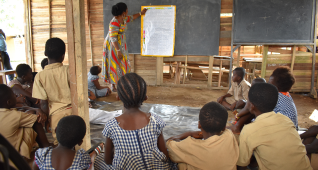Teaching at the Right Level
Teaching at the Right Level enables children to acquire reading and arithmetic skills in a short period of time and at a relatively low cost.
Introduction
7 out of 10 children in low and middle-income countries are unable to read simple text by age 10.
In many contexts, this translates to many children completing 3 years or more of schooling, without the appropriate skills to read simple text or perform basic math operations. The challenges in acquiring foundational skills are often compounded by large variations in learning levels in the classroom and overambitious curricula. As decision-makers and stakeholders double down on this crisis of learning, TaRL may present an evidence-driven solution to strengthening children’s foundational skills.

About TaRL
Children, who are 7 or 8 and older and have been in school for a few years, can “pick up” quickly. TaRL is an accelerated learning approach that enables children to acquire reading and arithmetic skills in a short period of time and at a relatively low cost.
How does TaRL work

At the start of the program learning goals are clearly articulated so that teachers and parents know what is to be achieved.

A simple assessment is used for grouping children for instruction. Later in the program, similar assessments are used to track children’s progress and for making course corrections.

Even though children may be enrolled in Grades III, IV or V, children are grouped by level rather than by grade. As children make progress, they move into more advanced groups.

Pratham’s method relies on a set of daily activities to maximize learning.

Appropriate low-cost teaching-learning materials are developed for the program; each group has materials to support their activities.
To be effective, the “Teaching at the Right Level” approach needs to be embedded in a larger ecosystem whose elements are aligned to support and ensure learning for all children. Here are the main features of the school system that need to be changed to ensure that learning for all is possible.
| KEY ELEMENTS | BUSINESS AS USUAL | TEACHING AT THE RIGHT LEVEL |
|---|---|---|
| GOAL | Goal is to complete the grade level textbook. | Clearly articulated goals for basic reading and arithmetic. The overall goal of the intervention is to ensure basic foundational skills for all. |
| TRAINING & MENTORING | Resource persons as trainers. Weak ongoing, on-site support by those who have trained teachers. | "Leaders of practice" created via "learning by doing. Select Government cadre "practice" the approach for 20-25 days and taste " success, then train teachers and provide ongoing on-site monitoring and mentoring. |
| GROUPING | Full class teaching at grade level. | Children are grouped by level rather than by grade for instruction. Children move quickly from one group to the next as they progress. |
| TEACHING & ACTIVITIES | “Chalk and talk”. Textbook driven. Teaching to the "top of the class" | A simple framework of daily activities that can be adapted as children progress. (CAMaL – Combined Activities for Maximized Learning). Activities in big groups, small groups, and individually. |
| ASSESSMENT MEASUREMENT DATA REVIEW | Pen-paper grade level test is done at the beginning of a phase and at the end. | A quick one-on-one oral assessment is used at the start for grouping. Similar assessments are used periodically to track progress. Data discussion and review take place at all levels. Aggregate school or class-level data is used to propel the program, not child-wise data. |

Guided Tour of TaRL
TaRL programs have been rigorously and repeatedly evaluated through randomized control trials (RCTs). Want to read more about TaRL?

TaRL Programmes
The TaRL approach has been effectively adapted, piloted, and scaled up in 20+ countries. Curious about learning outcomes from TaRL programs?
Partnerships
The context and needs of each TaRL program are different, which is why our expert team provides end-to-end technical assistance for designing, delivering, and scaling TaRL interventions across the globe.
How do we support partners on TaRL?

1. Preparation Phase
Co-designing TaRL interventions and stakeholder alignment.
We start by understanding the project's needs, available resources, and timelines. Through close collaboration with stakeholders, we co-design TaRL interventions that align with the specific context, ensuring maximum impact.

2. Planning Phase
Advisory and review support with ongoing implementation.
We aim to establish in-country teams to directly support education programs, fostering networks in similar socio-cultural contexts for collaborative scaling efforts.

3. Implementation Phase
Co-creating teaching-learning materials and capacitating stakeholders on the approach.
Together, we co-develop materials tailored to the unique requirements of the TaRL program. During this phase, we provide intensive training to build leaders of practice i.e. individuals who practice TaRL themselves and serve as mentors or trainers in TaRL interventions.

4. Scale Up Phase
Review and course correction.Once a pilot is conducted, we help partners and implementers review the program and brainstorm pathways to scale the intervention sustainably